Another Club Reunion
The Club decided to hold a reunion in 1960 “to mark the Club’s 50th season in the Maitland competition”.
The notion that the Club would be fifty years old was a mistaken one based on the misconception that the Club was founded in 1909 when actually the correct date was 1903. For many years the Annual Reports of Northern Districts Club had the words “Founded in 1909” listed under the Club name on the front cover. Later it was amended to “1905” but even this was still two years out. Possibly the confusion arose with the loss of Club records and the time lapses in a competition that had occurred during the two wars so that the mistake was simply perpetuated.
Anyway, the Club decided to celebrate its 50th year with a reunion social for the evening of Saturday, October 8, 1960, with a cricket match to follow on the afternoon of October 9 at Lorn Park.
In the match between Past and Present Players, more than 460 runs were scored in the four hours of play.
The Past Team consisting of former playing members of the Club, hit up 233 with Norm Dolman scoring 56 and Athel D’Ombrain rattling up a quick 50, both scoring almost entirely in boundaries.
For the Present team, Col Elliott hit a breezy 57 and Dave Rutherford a fast 40. Whether by collusion or coincidence, the match ended in a tie when the then captain of the Club’s first grade team, Col Johnston was run out in trying to steal the winning run.
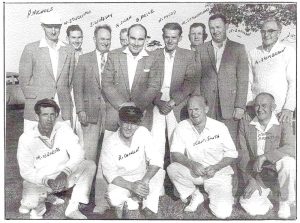
Front (Left to Right): M. Osborne, R. Conlin, Ken Smith, N. Proctor.
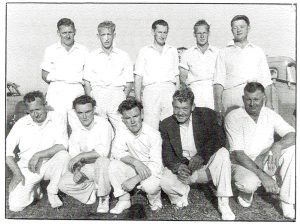
Front (Left to Right): W. Brooker, A. Elliott, C. Elliott, C. Johnston, R. Moylans Senior.
An Indian Visit
In 1961-62 the Club hosted a visit by a team from the Cricket Club of India. The match was played against an Old Collegians X1 at Lorn Park. The organisation for the match was mainly done by Colin Johnston who the previous season had gone on an Old Collegians World Tour which involved 65 matches in 53 countries.
The Maitland side was made up of Sonny de Carvalho, John Hayward, Jimmy de Courcy, Doug Walters, Col Johnston, Col Elliott, David de Carvalho, David Evans, Dave Rutherford, Doctor John Blomley, and Bruce O’Sullivan.
Dave Rutherford has two distinct memories of the match and the entertainment afterward: “1. The art of using spit to keep the ball shiny was so aptly demonstrated by Doctor John Blomley … As a young spinner waiting his turn at the bowling crease wishing that this man would suffer a sudden loss of mouth moisture, I can still see the Indian batsmen playing and missing his late inswingers and outswingers. His match figures were 6-33 ………… 2. The other memory I have of this game was the dinner put on by Col at his home where his wife had put on all the Indian curry dishes possible. From one who was considered as being good on the tooth, I can still remember the ample portion of all these curry dishes I was given, and the look of surprise which must have shown on my face when taking the first few mouthfuls, much to the enjoyment of the elders, but found that as long as you have a large jug of water beside you no finer curry dishes could be found .. “
More Chegwyn Matches
There had been two earlier visits of Chegwyn teams to Lorn Park in the 1940’s and these had been followed by another in 1953. During the 1960’s there were to be two further visits – one in 1962 and the other in 1966.
Jack Chegwyn’s team in 1962 was a “star-studded” line-up that included Willy Watson, Warren Saunders, Ji m Burke, Graham Thomas, Jim de Courcy, Sid Carroll, Norm O’Neill, Doug Ford, Gordon Rorke, Ron Guy, and Gamini Gooneseena.
The Maitland team was captained by Col Johnston and included a number of other Northern Districts players – David Rutherford, Colin, and Allan Elliott. The main interest in the Maitland team was the inclusion of Doug Waiters from Dungog. Col Johnston later claimed that he selected Doug “sight unseen” to play against Chegwyn’s X1 on the recommendation of John Hayward, who at that stage was Maitland’s Association Secretary and representative captain.
This match was to be an important stepping-stone in Doug’s cricket career. In the first innings he took 4-28 with Watson, Saunders, O’Neill, and De Courcy among his victims, and in the second innings scored an impressive 51 not out. Within three months Doug was to be selected in the State Colts and the State team. So some of the credit for starting Doug on his way to a famous State and Test career should probably go to this match at Lorn Park.
David Rutherford also had his moment of glory in the match when he captured the wickets of Burke and Thomas with successive deliveries.
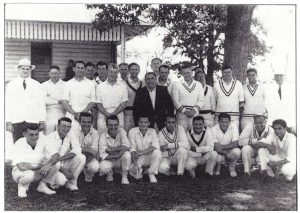
Front (Left to Right): K. Bromage, D. Walters, C. Elliott, A. Elliott, J. French, D. Ford, J De Courcey, Ron Allen, S. Carroll, G. Goonesena.
Chegwyn’s 1966 team was another impressive line-up with Norm O’Neill, Peter Philpott, Dave Renneberg, Brian Taber, Graham Corling, Geoff Davies, Lyn Marks, David Sincock, Kerry Owen, Terry Lee, Gordon Goffet, and John Benaud.
John Cox captained the Maitland team which included five other players who were then currently with Northern Districts – Allan Elliott, Doug Rawling, David Rutherford, Warren Trappel, and Jeff Crittenden. There were also two former Norths’ players – Terry Finch and Colin Elliott.
Doug Walters who was doing his National Service training at Singleton Army Camp was again included as a guest player. However, on this second occasion, he was a little out of form as he had not handled a bat for six months and was dismissed for 4 in the first innings and 10 in the second.
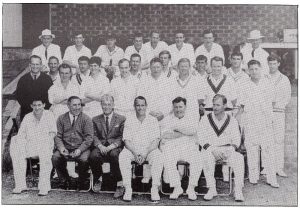
Third Row (Left to Right): D. Rawling, G. Corling, G. Goffett, J. Benaud, G. Davies, D. Renneberg, T. Lee
Second Row (Left to Right): N. Loss (Secretary MDCA), C. Elliott, J. Crittenden, L. Marks, Ray Allen, K. Owen, D. Sincock, Ron Allen
Front Row (Left to Right): B. Taber, J. Chegwyn, C. Johnston (President MDCA), N. O’Neill, J. Cox, P. Philpott
A New Pavilion
During the 1966 Chegwyn match a new pavilion and grandstand at Lorn Park were officially opened by E.G.Macmillan, President of the NSWCA and Chairman of the Board of Control, who was also the brother of former leading local player Ross Macmillan.
The new brick pavilion can clearly be seen as the background in the 1966 Chegwyn group photo compared to the wooden pavilion background in the 1962 group photo.
The new pavilion was constructed by Maitland City Council and was a marked improvement on the previous structure which dated back to 1921.
One of the Club’s amenities that would have been transferred over to the new pavilion was a second-hand refrigerator that had been purchased by the Club in 1961-62.
In front of the pavilion, a barricade net had also been erected in the early sixties by the Maitland Baseball Association and this served as the back netting for the practice wickets used by the Club.
More Association Changes
This period saw some more changes by the Association in the format of the competition.
The system of Club cricket continued but in 1974-75 the competition was reorganised into two divisions. First Division consisted of clubs with teams in first, second, and third grades playing a series of two and one-day matches, while the Second Division was made up of A, B, and C grades. Individual grading of players was also abolished with First Division clubs being allowed to grade their own players.
Northern Districts were one of the eight Clubs that were included in the First Division. The following season the number of First Division clubs was increased to ten with the inclusion of Morpeth and East Maitland United.
A Club Championship and a Player of the Year Award were introduced for each Division.
In addition, teams leading on points at the end of the competition rounds would be deemed to be minor premiers, and the winners of the finals would be the major premiers.
Another change that occurred during this period was the introduction in 1970-71 of semi-finals to replace the system of a minor and major final that had operated for two seasons. The semis were played in all grades on the Saturday and Sunday following the last competition game, with the first playing third and the second playing fourth. The final was then played the following weekend.
Further Success
During the eleven seasons from 1966-77, Northern Districts Club continued to have its share of success. The first grade won six premierships – three consecutive ones from 1966-69; two more in 1970-71 and 1972-73; and the minor premiership in 1976-77. The first grade participated in seven finals and won three of them – in 1966-67; 1968-69; and 1973-74. This meant that in two seasons – 1966-67 and 1968-69 – the first grade completed the double by winning both the premiership and the final. The second grade was less successful but won both the premiership and the final in 1969-70 and 1972-73. The third grade’s lone success was in 1975-76 when it won the final to take out the major premiership. The Club won two Club Championships – in 1966-67 and 1972-73.
One of the best seasons that the Club has experienced was in 1972-73 when it won the Club Championship, the first grade premiership, and the second grade premiership and final. Chief opposition again came from Easts which contested five finals against Norths.
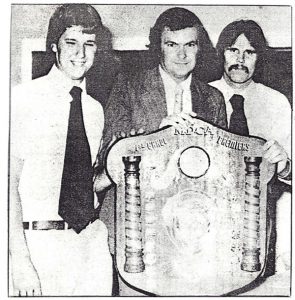
A New Look First Grade
With the retirement of a number of long-serving players from first grade and the transfer of a number of others from the district and to other clubs, the first grade took on a “new look” during this period.
In the midst of all the changes, there was to be one constant that remained – that was David Rutherford who played for the entire eleven seasons and continued to pick up “a swag of wickets” each season. Another who played for most of the period was opening batsman and long-serving Club-man, Doug Rawling.
However, the retirement from first grade of Colin Johnston, Alan Johnston, and Robin Cotton, as well as the transfer from the district and to other Clubs in the late sixties by John Cox, Allan Elliott, Glenn Brooker, and Jeff Crittenden, opened the way for “some new faces” in the first grade line-up.
Among these was a promising crop of youngsters with players such as David and Peter Rawling, David Johnston, Michael Cox, Will Callinan, Alan Mudd, Patrick Moylan, Les Vickery, Phil Warby. Georqe Wolstenholme jnr.,Philip York, Paul Hewitt, and Des Hitchcock.
Up until 1971, the veteran Keith Smith continued to open the bowling with Warren Trappel. When Keith stepped down Trevor Deamer opened up the attack, and then later on Les Vickery was promoted to first grade to fill the gap created by Warren’s transfer to another club.
In the spin department, David Rutherford was the stock bowler and was backed up at various stages by Peter Rawling and Phil Warby. The Club was particularly well-served during this period by wicket-keepers. Following the transfer of Colin Elliott, the gloves were donned by Jeff Crittenden, who in turn was followed by David Johnston, Michael Cox, and Will Callinan.
The captaincy of the side changed on a number of occasions. Starting off with John Cox, the role was subsequently taken on by David Rutherford, Doug Rawling, David Rawling, Trevor Deamer, and Jeff Crittenden.
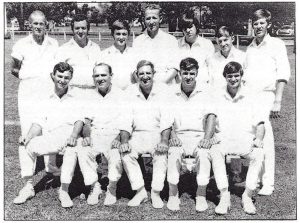
Front (Left to Right): G. Wolstenholme, R. Cotton, Doug Rawling, W. Trappel, David Rawling
A Close Final
Of the seven finals that the first grade contested during this period, none was closer than that in 1973-74 against Black Hill.
The match proved to be a fitting climax to the season for it produced the closest finish seen in a Maitland first grade final for many seasons.
On the Saturday Black Hill which was appearing for the first time in a first grade, final batted and after a steady start was 2 for 46 when a thunderstorm washed out play for the day at 2.15 p.m . Resuming the next day, the Black Hill batsmen found runs hard to come by on the soft wicket and were dismissed for 136, with Alan Wells top-scoring with 69. The most successful bowlers for Norths were Warren Trappel with 4-47, David Rutherford 3-39, and Peter Rawling 2-26.
After a solid opening partnership of 35 between Doug and David Rawling, Northern looked set for a comfortable victory. However, wickets began to tumble to the left-arm spin of former Norths’ player, Paul Moore.
Northern still needed 4 runs to win when its last batsman, Trevor Deamer came to the crease. Trevor and young Des Hitchcock hung on grimly to score the winning run off the second last ball of the last over of the match. Paul Moore finished with the outstanding bowling performance of 8-43 off 15 overs.
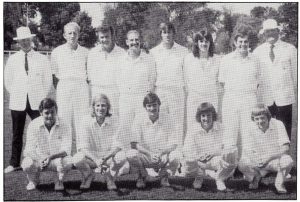
Front (Left to Right): A. Mudd, P. Rawling, David Rawling, W. Callinan, D. Hitchcock
Third Grade Triumph
One of the few successes of the Club in third grade was achieved in 1975-76 when the team won the final to take out the major premiership.
The win was remarkable in that on more than one occasion the team survived a “near-thing” that could easily have snuffed out its chances. As described by the team’s captain, Colin Johnston: “Over the years Norths have won plenty of premierships and finals – maybe not many in third grade – but it is certain that no past success has been as
dramatic or as unexpected as that achieved by the thirds last season.”
Coming to the last round, the team was in fifth place and had to play the fourth-placed side, Raymond Terrace, in a two-day match. After the first day’s play was washed out, Northern gained an easy first innings win on the second day to put them into the semi-finals just ahead of the Terrace on averages.
In the semi-final, Northern was opposed to the strong Easts team which had won the minor premiership by a big margin. After Saturday’s play was washed out, Northern was sent in the next day on a wet wicket. They managed to score 157 with Jack Horseman (who had returned to the Club after three years in Canada) contributing a fine 101. In reply on a much easier wicket Easts were restricted by some tight bowling by Don Nichols and Keith Smith and were dismissed one run short of Northern’s total – a result that had to be checked and verified by the Board.
The final played against Black Hill on SMR wicket was again affected by rain.
After dismissing Black Hill for 91, Northern gained a narrow first-innings lead of 20 runs by scoring 111. Black Hill was then bowled out for 61 with Keith Smith and Gary Spohr each taking 4 wickets.
The 41 runs needed for victory did not seem too difficult. However, the side collapsed to be 9 for 27 and was on the brink of defeat. At that stage, Keith Smith joined Graeme McKimm at the crease. The outcome is best described by Colin Johnston: “One wicket to fall, the wicket bad, the opposition on top and 15 runs to win. Black Hill bowlers probably tried too hard and dropped them short. Some lusty hooks by Graeme, a deft shot over slips by Keith, and we were there. Eddie French (who had played for years without winning a cap) had his cap and so did the rest of us.”
For Col the win had particular satisfaction: “And so, starting in 1930 as the youngest in North’s thirds and playing my very first match on the same ground that we won the final in 1976, the circle seems to be completed for me”. Actually, after this victory, Col was to continue to play for another five seasons before hanging up the boots!
A Family of Century Makers
The Rawling family created an unusual record in Maitland cricket during the 1974-75 season.
Father Doug and his three sons, David, Peter, and John, all scored centuries. Doug scored 118 in a first grade match for Northern against Black Hill. David, the captain of Northern’s first grade team, scored 114 against Eastern Suburbs. Peter, who was captain of Police Boys at the time, scored 113 in a first grade match against Eastern Suburbs.
John scored 103 not out for Northern’s third grade in a match against Police Boys.
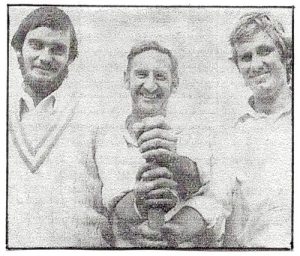
The only member of the family who failed to score a century was Doug’s wife, Edna!
Third Grade Guardian
Over the years the Club has been fortunate in having a number of experienced players who have been prepared to play in the lower grades and be a guide and mentor to the younger players.
Don Nichols was one such club man. He had a long association with the Club extending over more than 20 years. Most of that time, apart from a couple of short breaks, was spent playing in third and fourth grades.
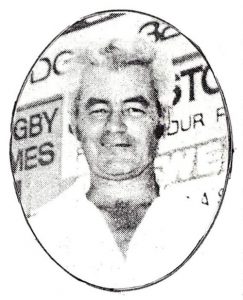
Don himself was quite a handy all-rounder and had the distinction of playing in the Club’s two winning third grade teams in 1964-65 and 1975-76. In 1964-65 he took 4-1 in an over against Combined City and a hat-trick in 1981-82.
However, Don’s greatest value was in the way in which he encouraged and looked after the younger players in the team and gave them a grounding that prepared them for the higher grades.
In 1965-66 when he captained the third grade team, the following Secretary’s note was added to his team report: “Mention must be made of the way Don handled the team and his work with the young boys of the team.
His own performances were of a very high standard – he scored 304 runs at an average of 21.7 and was equal with Bernie McNally with the aggregate number of wickets – 31.”
Don had the knack of being able to find a player if the team was short and regularly looked after transport arrangements for the younger players.
He was a very active Club-man and served at various stages on the committee, as a Selector, Public Relations Officer, and as President (1976-77). He was also on the Association’s Board of Control from 1983-86 and was involved in the organisation of the Ten Over Competition and the Association’s Coaching Clinics.
Ray Whiteley, the fourth grade captain in 1983-84, summed up Den’s value as a team and Club-man when he wrote: “A special thank you to Don Nichols, affectionately known as ‘Mr.Nichols’ to the team. Don as always was untiring in his efforts with the side. He looked after the kit collected game fees and tossed the coin … Personally, Don did well with both bat and ball. He was heard to say such things as ‘That’s the best I’ve bowled for a while’ or ‘I was going to hit it … but … etc’ … Don really enjoys the game and was an inspiration to all in the side.”
Two Links With New Guinea
Club members were saddened to learn in 1972 of the death of Flight Lieutenant Graham Thomas.
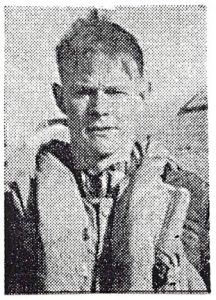
Graham, aged 25, was killed when the RAAF Caribou aircraft which he was piloting crashed in New Guinea. At the time he was flying a group of school Army cadets from Lae to Port Moresby.The plane came down in a heavily-timbered and ravine-studded mountainside about 18 miles south of Wau.
Graham had previously played with Northern Districts and Black Hill Clubs. He was a top-class left-hand opening bowler who could have gone on to considerable success in the sport.
On a brighter note, Club members were pleased to hear in 1975-76 of an honour accorded in New Guinea to one of their former players, George Wolstenholme Jnr.
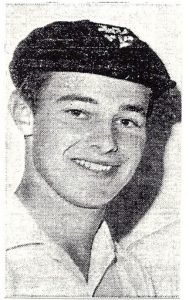
He was appointed captain of the first Papua-New Guinea cricket team to play in an international match, shortly after their independence.
He captained the team in matches in Port Moresby and Lae against the West Indies, prior to the start of their Australian Test tour.
At the time, George was a member of the Australian Army forces stationed in Port Moresby for 18 months and had been playing with a Defence Forces team in the local competition where he had won the best and fairest for New Guinea cricket the previous season.
Prior to going to New Guinea, George had played two seasons in first grade with Northern Districts from 1969-71. In his first season, he had topped the Club’s batting average.
On his return from New Guinea, he was to resume playing at a later stage with the Club.
Sportsman Dinner
During the 1976-77 season, the Club organised a Sportsman’s Dinner.
This function which was held at Lorn Park Bowling Club was mainly arranged by two loyal Club supporters, Tom Morgan and Ian Haxton.
It aimed to bring together past and present Norths players and “thus cement the bonds of the Old and Esteemed Club”.
The guest speaker at the Dinner was Alan Davidson, President of the NSWCA and former Australian Test all-rounder.
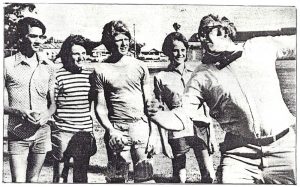
While in Maitland, Davidson gave some coaching tips to some of Norths’ young players.
Club Sponsorship
Over the years it has been a constant struggle to keep the Club financially viable.ln addition to membership and playing fees, Club finances have needed to be supplemented by a variety of fund-raising methods such as raffles, “100 Clubs” and canteen sales.
The 1976-77 season marked a new initiative with Club sponsorship being arranged – a trend that was to continue in later years.
Tony Williams of A.J.F.williams Insurances agreed to sponsor the Club and this sponsorship “greatly helped to provide adequate gear” for the junior and senior sides.
The following season additional’ sponsorship was gained from “Booths Sport ‘N Things” to make the Club one of the first in the District to have dual sponsors.
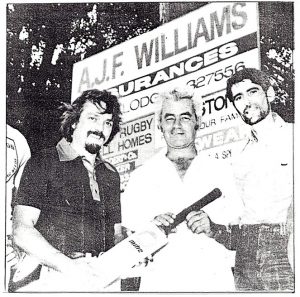
The extra financial support enabled the Club to fix the sightscreen and to purchase a slips machine and some cricket gear.
Two Sheffield Shield Products – David Johnston
David Johnston was the son of Colin Johnston. As a schoolboy, he had shown outstanding promise.
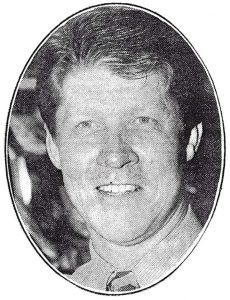
After being selected in the State Primary School team, he represented the State in 1967-68 as a wicketkeeper-batsman in the Under 14 Schoolboys team at the interstate Carnival in Adelaide. He was again chosen the following year.
At the age of 14, he gained selection in the NSW CHS Open Schoolboys team that toured Queensland in 1969- 70. He was selected again the following year and scored an impressive century against a strong NSWCA team.
For two seasons from 1969-71, he captained the CHS Under 16 team that played in the Green Shield competition in Sydney. On two occasions he won the Stan McCabe Trophy for the outstanding batsman in the competition. He also scored 127 not out for the Combined Green Shield team in a match against the Combined Country Coaching Class.
In 1971-72 he toured Ceylon with an Australian Schoolboys team.
In 1965 at the age of 10, David started playing third grade with Northern Districts. His captain, Don Nichols, described him as “a very handy fielder and wicket-keeper who likes to hit the ball hard”.
He spent another two seasons from 1966-68 in third grade. ln 1967-68 when he scored 243 runs, he received special mention for an innings where he “carried his bat” through the innings to equal a similar performance by his father at the start of his career: “One of the best batting performances of the season was David Johnston’s innings against SMR at the Leagues wicket. No other batsman in our team scored double figures. David opened the innings and scored 51 not out in a total of 79 – a very fine performance indeed.”
In 1968-69 he came up from second grade and played about half the season in first grade scoring a modest 56 runs from 6 innings. The following season he had the opportunity to take over the first grade wicketkeeping position when Jeff Crittenden moved to Sydney. He played a full season and scored 201 runs from 15 innings.
His time in the Club’s first grade was to be fairly brief as he went to Shore College in 1971 to complete his secondary education. He played the first half of the 1970-71 season, scoring 91 in the first match against GUOOF, and had a few matches in the school holidays in the 1971-72 season.
After leaving school he played first grade with North Sydney. It was while there that he began to attract the attention of the State selectors, particularly after scoring an unconquered century against Mosman.
In 1974-75 he was selected in the State Colts and three years later in 1977-78, he was chosen in the State team for the Sheffield Shield match against Western Australia at the SCG.
His selection marked the first time that a Maitland player had been chosen for the State since Frank Cummins in 1932-33.
Originally named as twelfth man, David received his opportunity when Graeme Beard withdrew because of injury and scored an impressive half-century on debut, which earned him a Shield place for the rest of the season.
Former Test bowler, Bill O’Reilly, was very impressed with David’s innings and wrote: “Batting with incredible confidence bordering at times on unadulterated cheekiness, this eye-catching newcomer won all the batting Oscars at the SCG yesterday. One seldom expects a youngster battling his way into the big time to go aggressively forward to his off-side shots – certainly not until he has some reason to think that his place in the team is secure. As for swinging hard into punishing on side shots, from the drive full circle around to the sweep, such behaviour is almost questionable when practised by a young fellow of whom nobody has heard a whisper.”
Over the three seasons from 1977-80, David played in 12 Sheffield Shield matches for the State. In his 22 innings, he scored 454 runs at an average of 22.7 with a highest score of 81. He also played in about eight Gillette Cup one day matches for NSW.
He was unfortunate in that his Shield career received a setback in the early stages when he suffered a broken finger facing Western Australian speedster, Sam Gannon, in a Shield match on a lively wicket in Perth during the 1978-79 season.
During his short Shield career, David had the distinction of giving Geoff Lawson his first Sheffield Shield wicket when he caught Geoff Marsh in the slips.
After retiring from the Sydney competition, David later played with University in the Newcastle competition during the eighties.
Then after a break from cricket, he followed in his father’s footsteps and the Johnston tradition by becoming involved with the local Maitland Association. He served on the Board of Control from 1994-97 and was very much involved in the organisation of the City Origin versus Country Origin match that was held in Maitland during the Association’s Centenary celebrations in 1994.
In 1997-98 he attempted a comeback with his old Club, Northern Suburbs, but in the very first match snapped his Achilles tendon and was forced to retire again.
Michael Cox
Michael Cox was the son of John Cox who had played first grade with the Club in the sixties.
Like David Johnston, Michael achieved a lot of success at the schoolboy level.
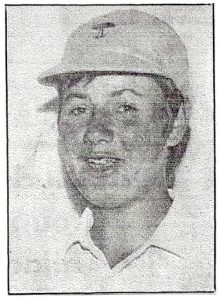
In 1968-69 he was vice-captain of the State Primary School team and in the following season captained the team.
In 1971-72 at the very young age of 14, he gained selection in the CHS Under 16 team that played in the Green Shield competition. In 1973 he was a member of a Newcastle CHS team that defeated a strong Sydney CHS side. From 1974-76 he was in the NSW CHS No.1 team and in 1975-76 was in the State All Schools team that competed in the Australasian Championships in Perth.
While attending Maitland Boys High School, he captained the 1st X1 that won the Davidson Shield Knockout competition in 1975 by defeating Forbes in the final – the first time that a country high school had won the competition. For his school cricket performances, he achieved the high honour of being awarded a CHS Blue.
After representing Maitland in the Colts and John Bull Shield teams, he was selected in 1972 as a 15-year-old in the Hunter Valley Colts team for the J.S.white Carnival at Tamworth. There he showed his wicket-keeping skills by dismissing ten batsmen during the Carnival and equalling a Carnival record by stumping five in one innings. This form won him a place in the Emu Colts team to tour Tasmania.
The Emu selection had particular significance for Michael as it marked the first time that the son of an Emu had been picked in a later Emu side. His father, John, had been a member of the 1949 side – the first-ever Emu Team.
Michael started playing with the Club as a ten-year-old in 1967-68 in third grade. At that stage he was showing some potential as a spin bowler, no doubt making use of some of the wiles taught to him by his father. During the season he took 11 wickets and scored 27 runs from 10 innings.
He continued to play third grade for another two seasons from 1968-70, picking up 24 and 23 wickets respectively. His captain, Don Nichols, described him as “another fine young player who bowls his spinners like a veteran … His batting is correct and will improve with his increase in size and strength.”
In 1970-71 his batting began to develop and his spin bowling gave way to wicketkeeping. After starting the season in third grade, he was promoted and finished the season in seconds.
The next season saw him make his debut in first grade at the age of 14. The team Report noted:”Michael Cox improved with every game. His ‘keeping for a boy of his age, was out-standing and with a full season in first grade behind him, should really develop into a first-class ‘keeper. Whilst his batting was not given many opportunities, enough was seen to realise his potential. With his improvement and a higher position in the batting order, he will score many runs in the season ahead.” 1972-73 was to be his last season with the Club.
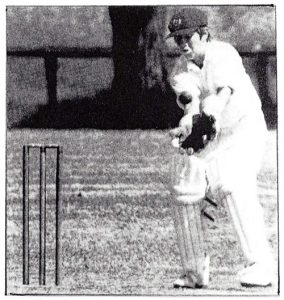
During that season he continued to show promise with his wicketkeeping and batting and won the Roger Moylan Memorial Trophy for the most improved Under 21 player in first grade. His captain, David Rawling commented: “Michael Cox – wicketkeeper and middle-order batsman. The baby of the side. True ability showed out last season. Batting was of a very mature nature, knowing when to go for his shots. Wicket-keeper of a high standard. Still has a few years to go for experience, but has the making to go far.”
A setback came in 1973-74 when he was forced on doctor’s orders to give away sport for eighteen months because of a back problem. While this was a major disappointment, he kept a positive outlook, seeing it as only a temporary setback “in his bid for a State cap”, and continued to retain his interest in cricket by taking up umpiring.
When he did resume playing cricket in 1974-75 he moved on to play with Charlestown in the Newcastle competition for two seasons. After that, it was on to Sydney where he played with Gordon in the first grade competition. While with Gordon he was selected in the State Colts and was named in the State Practice Squad for 1979-80.
Like many NSW cricketers who have moved interstate with the hope of having greater opportunity to play in the Shield competition, Michael moved to Perth. There he was to achieve his goal in 1985-86 when he was selected to play for Western Australia after the regular State keeper, Tim Zoehrer, was called up for Australian Test duties.
Michael played six Sheffield Shield matches for WA in the 1985-86 season and as a wicketkeeper took 19 catches and 2 stumpings. He also joined a select group of ‘keepers, including Rod Marsh and Barry Jarman, who have taken five or more dismissals in a Shield innings. In his six innings he scored 88 runs with a highest score of 31.
In 1986-87 he also played for WA in a first class match against Mike Gatting’s MCC team – a match in which he took 4 catches. He also played four matches for WA in the Australian One Day Competition, taking 10 catches and scoring 61 in 3 innings.
Later, when reflecting on his cricket career, Michael wrote: “My first memories of cricket revolve around the Northern Districts Club and of the people involved. These people included players and gentlemen such as Col Johnston, Trevor Deamer, Doug Rawling, and of course my father. I was very disappointed when selected in first grade at the age of 14 and my father retired. However, the background of knowledge passed on to me by these gentlemen was invaluable and held with great esteem over my career.
A Motorised Roller
Northern Districts were one of the first Clubs in the District to use a motorised roller.
The existing roller was modified at a cost of about $200 and came into use during the 1974-75 season.
The 1973-74 Report noted: “Alan Curtis has done a wonderful job on the roller and is proud of the effort and result of the work and thought that has gone into this ‘Rolls Royce’ of wicket rollers.”
The following season it was reported that “the acquisition of the new roller” had seen “a return to some very fine wickets at Lorn Park with some very high scoring matches being played in all grades”.
Robin Cotton
Robin Cotton came to the Club in 1956-57. He had played the previous season with Eastern Suburbs and prior to that with Branxton from 1952-55 and with Western Suburbs in the Sydney first grade competition.
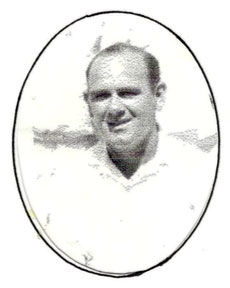
He was a right-hand leg spinner and batsman with a wide repertoire of shots on both sides of the wicket. In his first season, he showed that he was a real gain for the first grade team.
The Club Report noted: “For ourselves, gaining Robin Cotton should more than offset the loss of Doug March and indeed his performances with the bat were splendid.”
In that first season, he scored 437 runs, including two centuries, and figured in two Club record-breaking partnerships. In a match against Central at Robins Oval, he scored 139 and shared in a fourth-wicket partnership of 135 with Doug Rawling. A month later he scored 101 and shared in an opening partnership of 169 with Colin Johnston in a match against Marists at the Sportsground.
However, he did not strike quite the same form with his spin bowling and finished the season with 17 wickets.
Two aspects that received a special mention during this first season were his enthusiasm and his slip-catching ability. The first grade Report commented that “like Rutherford, he was wonderfully keen at all times, in both matches and at practice”. It also referred to some “excellent catches” that he had held in slips – 14 in all for the season.
During his time with the Club, Robin was to become renowned for his slip-catching ability. This was restricted somewhat during the two seasons from 1957-59 when he shared the wicket-keeping duties with Terry Finch and Colin Johnston. However, for most of the other seasons that he played first grade, his slip catches were regularly in the double figures. The 1961-62 Report acclaimed him as “easily the most accomplished slip fieldsman in the district”; the 1964-65 Report stated that “as usual his superb slip- fielding netted him a great number of catches – 15”; and the 1967-68 Report referred to his17 slip catches for the season, some of which appeared to be impossible.
Robin even seems to have developed a “slips whistle”. The 1966-67 Report noted: “Robin also developed a new style for slip fieldsmen. When one of our players was chasing an opposition shot, Robin would burst forth with a wonderful whistle, but I feel this not only confused the opposition batsmen but also most of the fieldsmen near him. However, it might be something new and may even be tried in a higher grade of cricket and if it is successful our ‘Cott’ will have really started something.”
He continued to play first grade up until 1971. With the bat, he was moderately successful but did not reproduce the form of that initial season until 1964-65 when he “had his best season for some time” and scored 405 runs at an average of 33.8.ln 1960- 61 he shared in another Club record-breaking partnership – this time a seventh wicket partnership of 78 with David Rutherford in a match against Black Hill at Marists wicket.
With David Rutherford in the team, Robin did not get much opportunity to use his spin bowling. However, in 1964-65 when David went to Waverley more use was made of Robin’s spinners and he ended the season at the top of the Club’s bowling averages with 17 wickets at 13.2 from 56 overs.
Apart from “a premature retirement in 1975-76”, Robin played second grade with the Club from 1971-80, captaining the team in 1973-74. There he continued to show his all-around ability, consistently scoring runs, taking wickets, and catching “some blinders” in slips. ln 1974-75 he notched up an unbeaten century against Police Boys at Lorn. His last season in 1979-80 when he scored 260 runs and took 27 wickets was among his best in second grade.
Despite a long playing career, he lost little of his enthusiasm for playing the game. The 1978-79 Report commented: “Then there’s our ‘Cott’. ‘Just one over Mate’. Mr.Nice Guy of second grade. Without ‘Joe’ Cotton, it just wouldn’t be cricket, mate. Without doubt, the best spin bowler going around the second grade ground these days!”
Doug Rawling
Doug Rawling started playing with Northern Districts in second grade in 1947-48. At that stage, his main strength was as a slow leg-break bowler and he hardly rated as a batsman. The Report for that season predicted: “Although Rawling only played a few matches with this grade, he showed distinct promise in his first season in competitive cricket. Halfway through the season, he developed a slow medium-leg spinner and showed himself to be a natural bowler. With plenty of attention to this delivery and plenty of practice and attention to length, Rawling could easily develop into an outstanding bowler.” Seldom has a cricket prediction been so far off the mark!
The following season he moved into first grade, bowling his leg spinners and batting last. He took 11 wickets and scored a mere 15 runs from 3 innings.
1949-50 marked a real turn-around in his cricket career. In that season he opened the innings and from then on was to become the Club’s regular opening batsman for more than twenty-five years, while his bowling faded into the background.
Apart from 1954-55 when he was injured in a car accident, Doug regularly scored in the range of 200-300 runs a season during the 1950’s. However, his best performances were to come later in the 1960’s.
In 1962-63 he scored 475 runs in the competition rounds, including an unbeaten century against Weston-Kurri, at an average of 47.5. The Club Report noted:
“Doug Rawling had his best season ever and this was a reward for his application and determination.He managed his goal of 500 runs just prior to his dismissal in the final. On only one occasion was he out for under double figures and this consistency meant a great deal to the side. Sometimes, however, he became too dogged and forgot to play the shots of which he is capable.”
The following season he headed the Club’s batting aggregate and average with 414 runs at 34.5.
In 1964-65 he had his best season and amassed 701 runs at an average of 58.4. At one stage he was on target to score 500 runs before Christmas – a feat that has only been achieved four times in the history of the Association. The Club Report tells the story:
“With a lowest score of 40, two centuries, and 3 not outs in his first seven innings, Doug Rawling started with wonderful consistency. At this stage, he had a remarkable average of 120 but was unable to achieve his object of 500 before Christmas. Subsequently, his best innings was 78 and, overall, he had a wonderful season.”
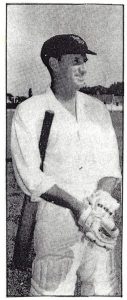
Doug continued to play up until 1975 when he moved to Sydney. During the latter part of his career, he captained the first grade team from 1970-72 and still remained one of the side’s leading batsmen. In the two seasons from 1972-74 he was still topping the Club’s batting aggregate and averages with 396 and 446 runs respectively.
Doug also had a long representative cricket career. In 1949-50 he was selected in the Hunter River team that participated at Country Week. For more than twenty years he was the opening batsman for the Association’s John Bull Shield and Coal Board Cup team, and in that role showed the same dogged determination as he did for his Club. On a number of occasions, he was the leading run-scorer in the John Bull Shield competition. ln 1963-64, for instance, when he scored his first century in representative cricket (120 against Gosford-Wyong) he headed the batting aggregate with 295 runs.
Doug’s batting style is best summed up by Col Johnston: “No one, perhaps not Doug, himself, would call him a stylish batsman. What style he had, he forged himself by trial and error. He eliminated those shots which do not present a full face of the bat to the bowler and he did this most effectively for himself and his Club and Association. At times he was criticised for slow scoring whilst he was waiting for the scoreable ball.
But, when the going was tough and the scoring was low when the wicket was doing things and the bowlers on top, nobody ever criticised him. Why? Because no batsman was more dogged, gutsier, more courageous, or more difficult to prise out than Doug Rawling.”
Doug was a tireless worker for the Club. At various stages, he served as Club Treasurer, Association Delegate, and Secretary. Apart from these administrative duties, he took on the job of curator for about five years in the early sixties. Countless hours were spent watering and preparing wickets, sorting out gear, arranging for balls, scorebooks, and the many other duties that fall to the lot of a willing club worker.
His dedication was aptly described by Col Johnston: “Always one of the first to arrive at the practice or the game, so that he could secure the last available second with his knock, he was invariably amongst the last to leave; having, of course, checked that all the gear and equipment was properly stored, and the scores were with the recorder and the newspaper.”
Doug’s work for cricket was not confined to the Club level. On the wider plane, he was Association Assistant Secretary in 1962-63 and from 1964-73 – a position that entailed the onerous task of the organisation of representative matches and selections. He was also Secretary of the Hunter Valley Cricket Council from 1966-75 and President of the Maitland and District Junior Association from 1970-73. For his services to cricket these three organisations, as well as his own Club, awarded him Life Membership.
Since its formation in 1903, the Club has had many dedicated officials and many fine and enthusiastic players, but none has been more dedicated on and off the field than Doug Rawling.
David Rutherford
David Rutherford at the age of 13 began playing third grade with Northern Districts in 1950-51 and in that first season took 20 wickets at 4.2.ln the Club Report he was described as ” … perhaps the outstanding junior to come to the club in years. A slow medium left-hander he has an easy action and for his tender years, spins the ball well and maintains a fine length”.
Col Johnston recalled that David used to appear at their early morning practices: “ln the 40’s and 50’s some of us practiced at 6 a.m., in addition to the normal afternoon practices. When we arrived in those fool old days a skinny blonde kid would be waiting for us. He was eight years of age, would chase the ball all over Lorn Park, and was delighted when time permitted him to have a few hits and bowl a few balls. Of course, that young fellow was Dave Rutherford.”
With 55 wickets in 1951-52, he was the leading wicket-taker in the Club’s third grade. At the end of the same season when someone pulled out of the first grade team because of appendicitis, David made his first grade debut in the final against Branxton and “under trying circumstances for one so young, did remarkably well”.
That was to be the beginning of a remarkable first grade career that was to extend for over thirty years.
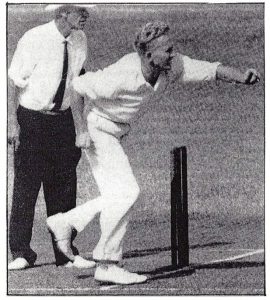
In his first full season in first grade (1952-53) David finished at the head of the Club and District bowling averages with 33 wickets at 6.6. The Club Report noted: “To be at the head of the leading Club’s averages is always a fine performance but for a young 17-year-old spinner to perform this feat in his first season with the seniors, is possibly a performance without parallel. Not only did David Rutherford do this, but he also headed the district averages. Altogether a memorable debut.”
Finishing at the top of the Club and District bowling figures was to become almost commonplace for David during his first grade career. For instance, from 1956-70 he was head of the Club’s bowling aggregate ten times and head of the District aggregate seven times. For eight of those seasons, he took over 50 wickets in the competition rounds.
On more than one occasion David took over 100 wickets in competition and representative matches in a season – a feat that has only been achieved by Roy Oakes, Mick Hinman, and Keith Smith. ln 1958-59 he took a combined total of 120 wickets – 68 in the first grade competition; 38 in Coal Board Cup and John Bull Shield matches; and a further 14 in matches leading up to his selection in Combined Country. In 1963-64 he surpassed that performance by taking 149 wickets, including 68 in first grade and 41 in John Bull Shield matches. In the final for that season against Combined City he had one of his best bowling results – taking 6-51 in the first innings and 4-56 in the second.
David’s enthusiasm for bowling was unbounded. On one occasion his first grade captain noted: ” … nobody was more enthusiastic than David Rutherford. As far as he is concerned, one thing is wrong with the game and that is the rule that precludes him from bowling at both ends. “No innings was too long for him and six o’clock was far too early to finish.
A newspaper report of the late fifties described David as “one of the busiest bowlers playing cricket. He never wastes a minute and if a batsman manages to rattle the pickets off one of his balls, Rutherford smiles, hurries to the crease and you can generally hear a different rattle”.
David had a very distinguished representative career. For more than twenty years he represented the Maitland Association in John Bull Shield and Coal Board Cup matches. Time and time again he finished with more than 40 wickets in a season – a remarkable performance considering that there were so few matches.
In 1953-54 he was selected in the Emu Colts team that toured NZ. He had a second tour of NZ in 1956-57 and finished as the leading wicket-taker. In 1960-61 he was selected for a world tour by the Emu Club.
During the fifties he was twice chosen in Combined Country teams that played against Metropolitan; and later on in the sixties, he was twice chosen in Northern NSW Country teams.
Two of his best representative performances were in 1963-64. In a match against Benaud’s NSW Sheffield Shield team – at Maitland Sportsground – David had a marathon spell of bowling in which he took 5-122 off 27 overs. At one stage he had taken 4-13 with his victims including Brian Booth, Doug Walters, Johnny Martin, and Terry Lee.
He put in another impressive bowling performance when playing for a combined Newcastle/Hunter Valley team against the touring South Africans in Newcastle. Off 33 overs he took 5 for 128 and among those he dismissed was Graeme Pollock, the outstanding South African left-handed Test batsman.
At one stage David went to Sydney in an attempt to further his representative career. He spent one and a half seasons with Waverley Club in 1964 and 1965. He won that Club’s bowling averages for 1964-65 and in one game took 12 wickets. However, he probably delayed his foray into the Sydney competition two or three seasons too long to gain the attention of the State selectors.
While there he narrowly missed being involved in a cricketing tragedy when half the Waverley team was killed in a level crossing smash en route to an up-country match. David was going to play in that match but decided to pull out at the last moment.
While David’s bowling gained most of the attention during his career, he was no slouch with the bat and figured in quite a few rearguard actions. His batting and fielding apparently developed from constant practice. As Col Johnston pointed out: “ln his very earliest days with the Club, Dave simply had no idea of batting or catching. He decided to do something about rectifying this in the only way possible – practice, practice, practice. As a result, he became a hard-hitting batsman who won matches, at say, number eight and developed into a splendid, energetic safe fieldsman, especially in the gully. “As his captain, Col advised him at one stage: “ln batting, though, he has yet to be convinced that a little early moderation can pay big dividends.”
In one Club match against Weston Kurri in 1955-56 he figured in a ninth-wicket partnership of 91 with George Emery only to fall 4 runs short of victory. In a Coal Board Cup match David, along with Arch Pankhurst, put on a last-wicket partnership of 128 with David registering his best ever score of 96 not out. He had his best season with the bat in 1974-75 scoring 320 runs.
David devoted himself to the Club and Association administration. He was Club Secretary from 1963-65; a Committee Member, Selector, and Senior Vice-President for many years; and also the Club’s curator for a number of seasons. He was the Association’s Representative Secretary from 1958-60 and served on the Board of Control from 1977- 84. For his services, David was made a Life Member of his Club and the Association.
David captained the first grade team for two seasons from 1967-69 and continued to play first grade up until the end of 1980-81. Then suffering from ill-health he played second grade for five seasons from 1981-86.ln his last season with the Club in 1986-87 he made a comeback to first grade and although he only took 12 wickets he still turned in some good performances such as his 5 for 55 from 13 overs against the strong Raymond Terrace team.
After 36 seasons with the Club David headed off to Tasmania following a transfer in his position with National Textiles. During his time in Maitland cricket, David took more wickets and bowled more overs than any other cricketer in the history of the Association. His wicket tally in competition and representative cricket would have been over 1500.
Not much was heard of David when he went down south but no doubt “Pops” continued to play cricket – bowled a few more overs and took a few more wickets.
A Double Act – Alan and Colin Elliott
The Elliott twins, Colin and Allan, are reported to have learned some of their early cricket skills on their father’s farm at Phoenix Park by bowling beetroot on the full toss to one another and clobbering them with a pick handle. Whether or not this was the case, they certainly learned at an early age how to play cricket and in particular, how to tear a bowling attack apart.
Both started out in 1956-57 playing in the Saturday morning Under 15 competition and then playing third grade in the afternoon with Northern Districts. Both finished the season with fairly modest figures – Colin scaring 83 from 10 innings and Allan scaring 23 from 10 innings and taking 7 wickets for 119.
For the next two seasons, both played third grade with Police Bays Club. lt was during this time that Allan took 58 wickets in 1957-58, including 9 for 0 against Raymond Terrace, and the following season scored 723 runs at 51.6 to top the District third grade aggregate and average. Colin also showed a lot of promise scoring 428 and 474 runs respectively.
It was mainly through their efforts that Police Bays won the third grade premiership and final in 1958-59.
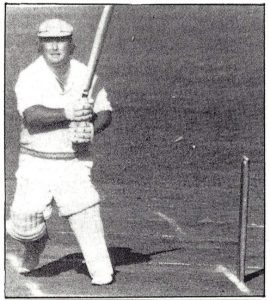
In 1959-60 both returned to Northern Districts and at the age of 15 made their debut in first grade. By the end of the following season the Club Report shows that they were beginning to have an impact: “Colin Elliott, also a splendid keeper, scored 309 runs at 20.6 … He is a splendid batsman full of real promise, and having done well in his overseas tour, could easily be the leading batsman for the club and district for years to come. Allan Elliott opened up in the latter half and showed this position suits him so that as he gains experience his performances must improve and he, like his twin, will be a real batting power for years to come. “Allan’s season figures were 232 runs and 11 wickets.
In 1961-62 Allan came to the fore to head the District batting aggregate and average with 558 runs at 50.4. The Club Report referred to him as “the star of the season” and went on to say: “lt is a feat to score over 500 runs in any season but to do so in a season in which so much cricket was lost and so many slow grounds encountered, is quite phenomenal. Allan started the season with 92 against City in 70 minutes of lovely cricket. He then had a comparatively lean period until his 129 against Weston-Kurri in conditions favoring the bowlers. This was an innings of real batsmanship. He used every shot in the book with a power and certainty that was a delight to watch so that many old-hands rated it as one of the best ever in Maitland cricket.”
This was followed by an innings against Easts that was rated as “fantastic”. On a damp wicket at East Maitland, he scared a hurricane 106 in a mere 30 scaring shots – 14 sixes, 1 four,3 twos and 12 singles. lt was reported that “he was certainly favoured by the short boundaries but, waiting for the right ball to hit and then hitting it with tremendous power, all of his sixes but three would have been over the fence on any ground”.During the season he hit 33 sixes in club games which, as with 14 in an innings, was claimed to be a record
With the ball, his best effort was against Wests. In a match in which they followed-an and with the attack weakened by various causes, he bawled 21 consecutive overs to secure 9 far 66 and an outright win.
During this same season, Colin was not far behind. He scored 415 runs in the competition rounds, as well as “a brilliant 51” in the final against Easts that was acclaimed as “an innings of real distinction and certainly the best he has produced so far”.His wicketkeeping also developed considerably “acquiring a consistency that was previously lacking” and led to a tally of 11 catches and 9 stumpings far the season.
The following season (1962-63) the tables were reversed. Colin took over from Allan as the team’s most effective batsman and headed the District aggregate with 526 runs at 58.4.
He scored two centuries and a 97 – his century against Black Hill was “a whirlwind affair with 6 sixes and 10 fours in 80 minutes and was chanceless”. His captain, Col Johnston, predicted: “With proper attention to the game, he could well follow Doug Waiters of Dungog into the State X1.There is little doubt he has the natural ability to do so.”
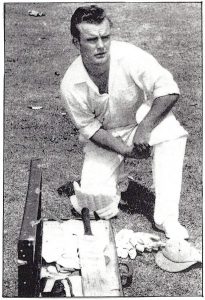
Allan, for his part, did not have the same consistency as the previous season but still finished with 320 runs. He also opened the bowling and took 15 wickets.
In 1963-64 both Colin and Allan left the Club to join Combined City and ended up playing against their former Club in the final. ln one match against Northern Districts Allan scored a hard-hitting 162. After 1963-64 Colin and Allan’s cricket careers followed different paths. Colin went to Sydney to play with Manly but after half a season returned to Maitland and joined Police Boys Club. In 1966-67 he transferred to Eastern Suburbs and remained with that Club for four seasons before going to play in Newcastle. While he was with Easts he became the second post-war batsman to score 500 runs before Christmas. ln his later years, he played with Penrith in the Sydney first grade competition.
On his return to Northern Districts in 1964-65 Allan was to have four very successful seasons with the Club. On his first season back he scored 494 runs, including two centuries, and a 98. One of his centuries was scored in a district record second wicket partnership of 256 with Glenn Brooker against Raymond Terrace at Lorn Park.
He followed this up with 316 runs in 1965-66 and then really came back to form in 1966-67 by topping the District aggregate and average with 525 runs, including two centuries, at an average of 75. He was again in the runs in 1967-68 topping the District averages with 60.2 and with 482 runs was only beaten by one run for the District aggregate by Terry Finch.
At the end of the 1967-68 season, Allan transferred to Western Suburbs Club where he remained for two seasons before moving to play in the Newcastle competition with his brother. ln his later years he returned to play in the Maitland competition and had one more season with Northern Districts in 1977-78.
During their careers, both Colin and Allan gained numerous representative honours. Both were selected for the Country Boys Coaching Class during their first season in first grade with Northern Districts. Both were Emu Colts – Colin went on the Emu Club World Tour in 1960-61 with David Rutherford, toured Tasmania with the Emu Colts in 1961-62, and was captain in 1962-63, while Allan toured Tasmania with the Emu Colts in 1963-64. Both also represented the Maitland Association for a number of seasons in the John Bull Shield and Coal Board Cup competitions.
Colin was selected on six occasions in Combined Country teams. He played for NSW Country against Ted Dexter’s MCC team .in 1962-63, against the South African team in 1963-64, and against Ray Illingworth’s MCC team in 1970-71. Against Benaud’s Sheffield Shield team in a match at Maitland in 1963-64, he opened the innings and “cut the cream of the State’s best bowlers to pieces to score 85 runs for Hunter Valley”.He reached his greatest height when he was chosen in 1964-65 in the State Colts team that played in matches against Queensland and Victoria.
There is no doubt that the Elliott twins were a very talented double act.



